Community Development of the ATSI Community: Rothman's Model Analysis
VerifiedAdded on 2021/04/24
|6
|1370
|46
Essay
AI Summary
This essay examines the community development of the Aboriginal and Torres Strait Islander (ATSI) community in Australia, highlighting the distinct cultures and challenges faced by these indigenous populations. It explores the application of Rothman's model of community organization, focusing on locality development, social planning, and social action as frameworks for achieving desired changes. The essay discusses the importance of indigenous knowledge, land rights, and the historical context of the ATSI community, emphasizing the need for social justice and recognition. It analyzes how the Rothman model can be used to address issues such as land rights and social inequalities, proposing strategies for community empowerment and progress. The conclusion emphasizes the need for immediate attention and collaborative efforts to support the development of the ATSI community.
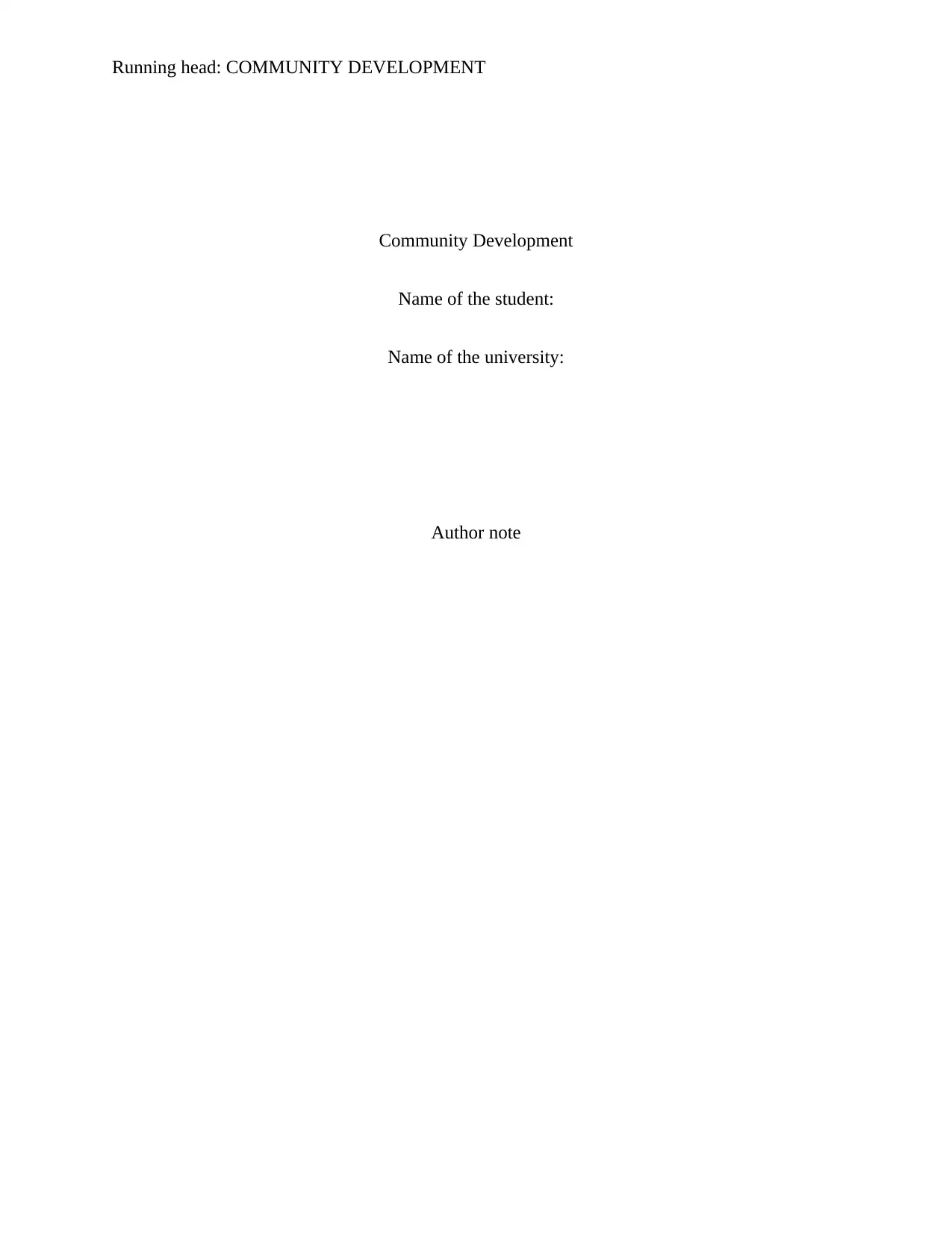
Running head: COMMUNITY DEVELOPMENT
Community Development
Name of the student:
Name of the university:
Author note
Community Development
Name of the student:
Name of the university:
Author note
Paraphrase This Document
Need a fresh take? Get an instant paraphrase of this document with our AI Paraphraser
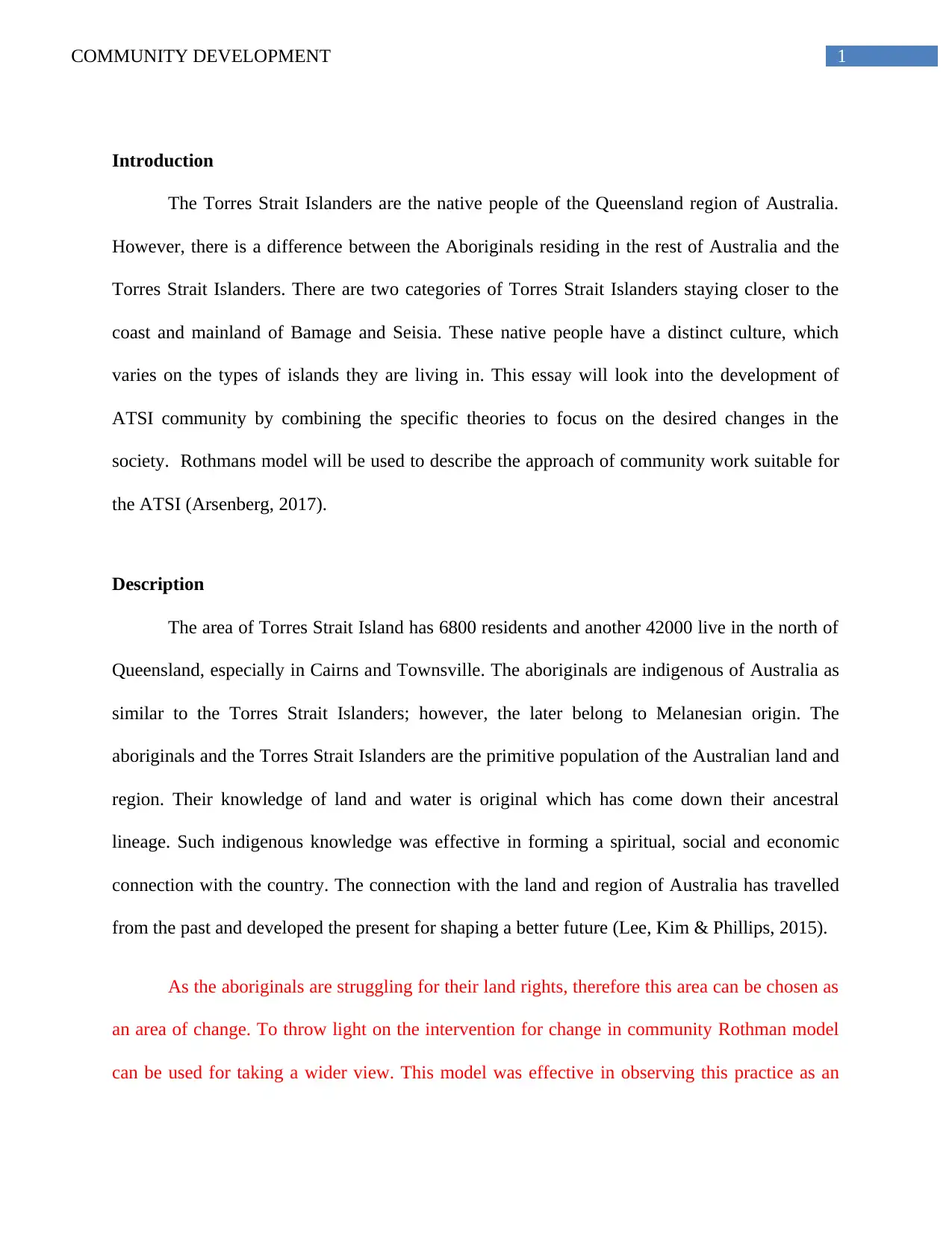
1COMMUNITY DEVELOPMENT
Introduction
The Torres Strait Islanders are the native people of the Queensland region of Australia.
However, there is a difference between the Aboriginals residing in the rest of Australia and the
Torres Strait Islanders. There are two categories of Torres Strait Islanders staying closer to the
coast and mainland of Bamage and Seisia. These native people have a distinct culture, which
varies on the types of islands they are living in. This essay will look into the development of
ATSI community by combining the specific theories to focus on the desired changes in the
society. Rothmans model will be used to describe the approach of community work suitable for
the ATSI (Arsenberg, 2017).
Description
The area of Torres Strait Island has 6800 residents and another 42000 live in the north of
Queensland, especially in Cairns and Townsville. The aboriginals are indigenous of Australia as
similar to the Torres Strait Islanders; however, the later belong to Melanesian origin. The
aboriginals and the Torres Strait Islanders are the primitive population of the Australian land and
region. Their knowledge of land and water is original which has come down their ancestral
lineage. Such indigenous knowledge was effective in forming a spiritual, social and economic
connection with the country. The connection with the land and region of Australia has travelled
from the past and developed the present for shaping a better future (Lee, Kim & Phillips, 2015).
As the aboriginals are struggling for their land rights, therefore this area can be chosen as
an area of change. To throw light on the intervention for change in community Rothman model
can be used for taking a wider view. This model was effective in observing this practice as an
Introduction
The Torres Strait Islanders are the native people of the Queensland region of Australia.
However, there is a difference between the Aboriginals residing in the rest of Australia and the
Torres Strait Islanders. There are two categories of Torres Strait Islanders staying closer to the
coast and mainland of Bamage and Seisia. These native people have a distinct culture, which
varies on the types of islands they are living in. This essay will look into the development of
ATSI community by combining the specific theories to focus on the desired changes in the
society. Rothmans model will be used to describe the approach of community work suitable for
the ATSI (Arsenberg, 2017).
Description
The area of Torres Strait Island has 6800 residents and another 42000 live in the north of
Queensland, especially in Cairns and Townsville. The aboriginals are indigenous of Australia as
similar to the Torres Strait Islanders; however, the later belong to Melanesian origin. The
aboriginals and the Torres Strait Islanders are the primitive population of the Australian land and
region. Their knowledge of land and water is original which has come down their ancestral
lineage. Such indigenous knowledge was effective in forming a spiritual, social and economic
connection with the country. The connection with the land and region of Australia has travelled
from the past and developed the present for shaping a better future (Lee, Kim & Phillips, 2015).
As the aboriginals are struggling for their land rights, therefore this area can be chosen as
an area of change. To throw light on the intervention for change in community Rothman model
can be used for taking a wider view. This model was effective in observing this practice as an
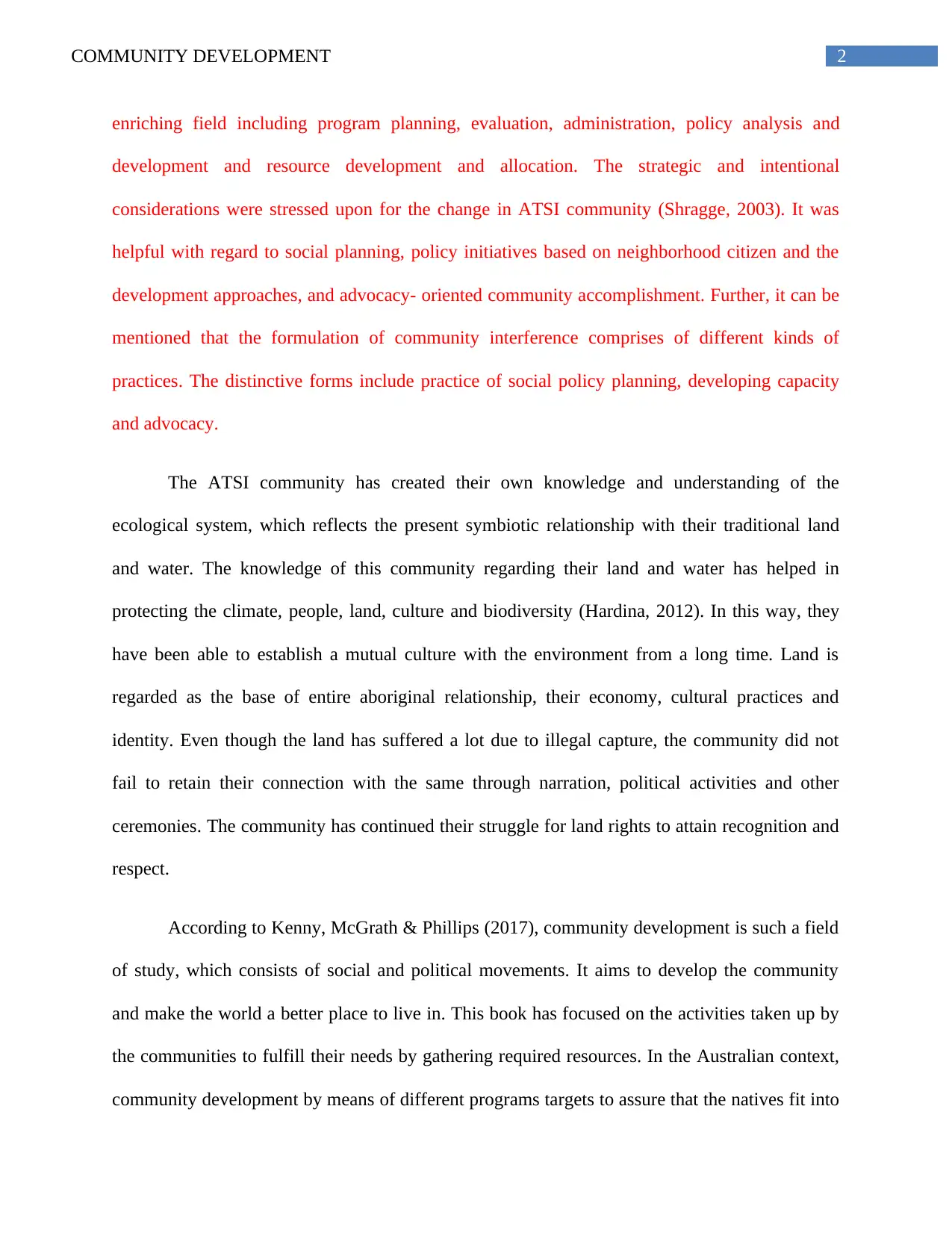
2COMMUNITY DEVELOPMENT
enriching field including program planning, evaluation, administration, policy analysis and
development and resource development and allocation. The strategic and intentional
considerations were stressed upon for the change in ATSI community (Shragge, 2003). It was
helpful with regard to social planning, policy initiatives based on neighborhood citizen and the
development approaches, and advocacy- oriented community accomplishment. Further, it can be
mentioned that the formulation of community interference comprises of different kinds of
practices. The distinctive forms include practice of social policy planning, developing capacity
and advocacy.
The ATSI community has created their own knowledge and understanding of the
ecological system, which reflects the present symbiotic relationship with their traditional land
and water. The knowledge of this community regarding their land and water has helped in
protecting the climate, people, land, culture and biodiversity (Hardina, 2012). In this way, they
have been able to establish a mutual culture with the environment from a long time. Land is
regarded as the base of entire aboriginal relationship, their economy, cultural practices and
identity. Even though the land has suffered a lot due to illegal capture, the community did not
fail to retain their connection with the same through narration, political activities and other
ceremonies. The community has continued their struggle for land rights to attain recognition and
respect.
According to Kenny, McGrath & Phillips (2017), community development is such a field
of study, which consists of social and political movements. It aims to develop the community
and make the world a better place to live in. This book has focused on the activities taken up by
the communities to fulfill their needs by gathering required resources. In the Australian context,
community development by means of different programs targets to assure that the natives fit into
enriching field including program planning, evaluation, administration, policy analysis and
development and resource development and allocation. The strategic and intentional
considerations were stressed upon for the change in ATSI community (Shragge, 2003). It was
helpful with regard to social planning, policy initiatives based on neighborhood citizen and the
development approaches, and advocacy- oriented community accomplishment. Further, it can be
mentioned that the formulation of community interference comprises of different kinds of
practices. The distinctive forms include practice of social policy planning, developing capacity
and advocacy.
The ATSI community has created their own knowledge and understanding of the
ecological system, which reflects the present symbiotic relationship with their traditional land
and water. The knowledge of this community regarding their land and water has helped in
protecting the climate, people, land, culture and biodiversity (Hardina, 2012). In this way, they
have been able to establish a mutual culture with the environment from a long time. Land is
regarded as the base of entire aboriginal relationship, their economy, cultural practices and
identity. Even though the land has suffered a lot due to illegal capture, the community did not
fail to retain their connection with the same through narration, political activities and other
ceremonies. The community has continued their struggle for land rights to attain recognition and
respect.
According to Kenny, McGrath & Phillips (2017), community development is such a field
of study, which consists of social and political movements. It aims to develop the community
and make the world a better place to live in. This book has focused on the activities taken up by
the communities to fulfill their needs by gathering required resources. In the Australian context,
community development by means of different programs targets to assure that the natives fit into
⊘ This is a preview!⊘
Do you want full access?
Subscribe today to unlock all pages.

Trusted by 1+ million students worldwide
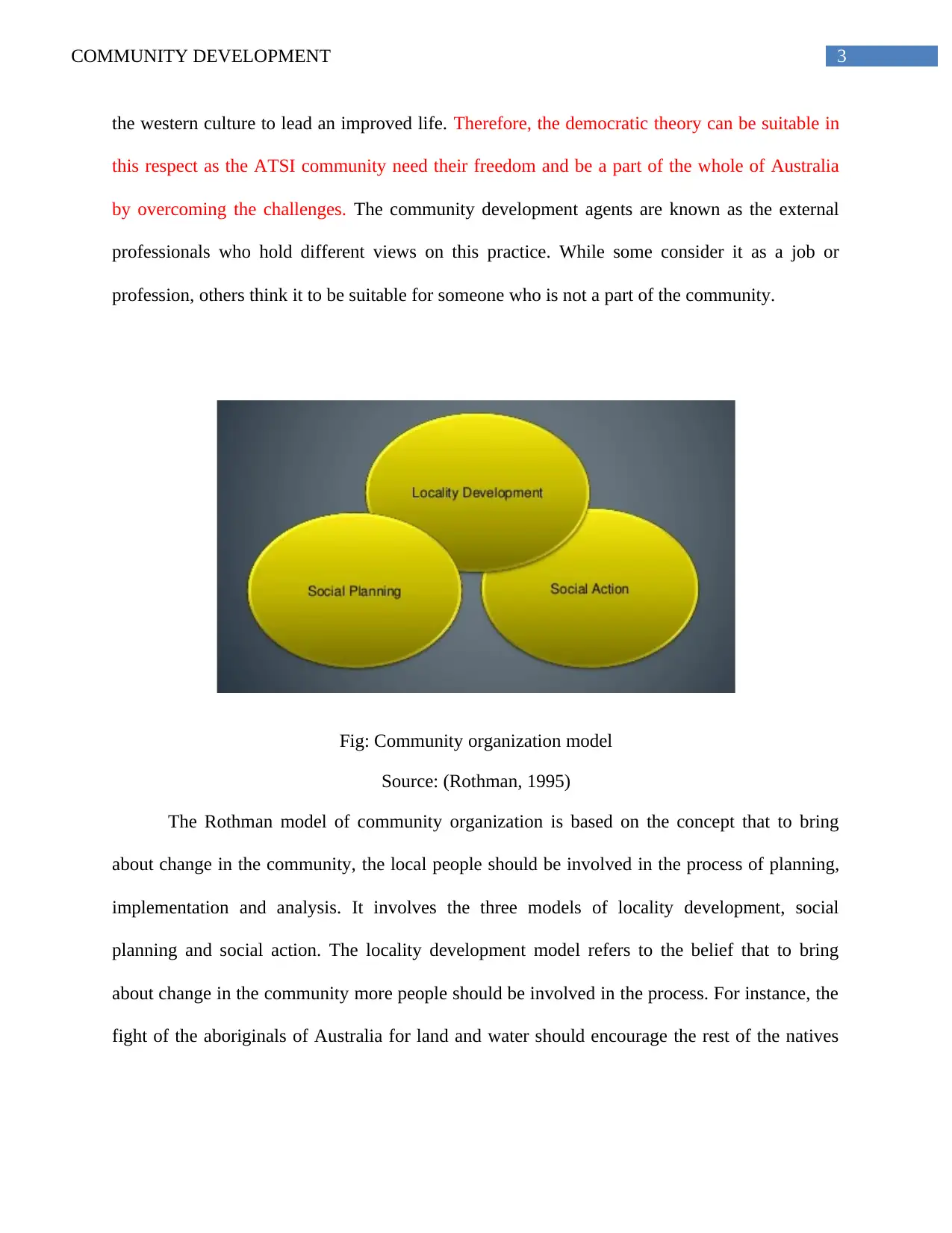
3COMMUNITY DEVELOPMENT
the western culture to lead an improved life. Therefore, the democratic theory can be suitable in
this respect as the ATSI community need their freedom and be a part of the whole of Australia
by overcoming the challenges. The community development agents are known as the external
professionals who hold different views on this practice. While some consider it as a job or
profession, others think it to be suitable for someone who is not a part of the community.
Fig: Community organization model
Source: (Rothman, 1995)
The Rothman model of community organization is based on the concept that to bring
about change in the community, the local people should be involved in the process of planning,
implementation and analysis. It involves the three models of locality development, social
planning and social action. The locality development model refers to the belief that to bring
about change in the community more people should be involved in the process. For instance, the
fight of the aboriginals of Australia for land and water should encourage the rest of the natives
the western culture to lead an improved life. Therefore, the democratic theory can be suitable in
this respect as the ATSI community need their freedom and be a part of the whole of Australia
by overcoming the challenges. The community development agents are known as the external
professionals who hold different views on this practice. While some consider it as a job or
profession, others think it to be suitable for someone who is not a part of the community.
Fig: Community organization model
Source: (Rothman, 1995)
The Rothman model of community organization is based on the concept that to bring
about change in the community, the local people should be involved in the process of planning,
implementation and analysis. It involves the three models of locality development, social
planning and social action. The locality development model refers to the belief that to bring
about change in the community more people should be involved in the process. For instance, the
fight of the aboriginals of Australia for land and water should encourage the rest of the natives
Paraphrase This Document
Need a fresh take? Get an instant paraphrase of this document with our AI Paraphraser
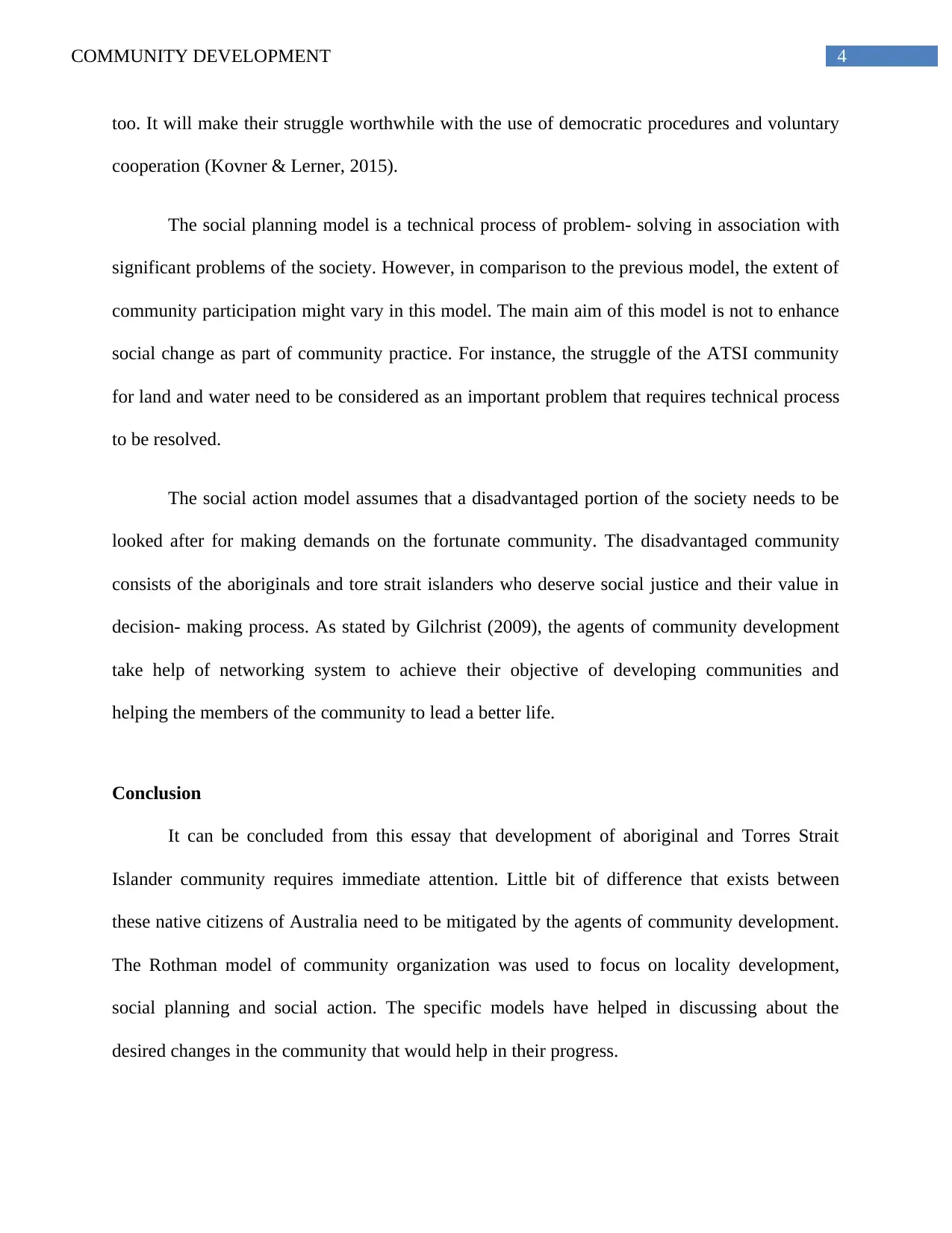
4COMMUNITY DEVELOPMENT
too. It will make their struggle worthwhile with the use of democratic procedures and voluntary
cooperation (Kovner & Lerner, 2015).
The social planning model is a technical process of problem- solving in association with
significant problems of the society. However, in comparison to the previous model, the extent of
community participation might vary in this model. The main aim of this model is not to enhance
social change as part of community practice. For instance, the struggle of the ATSI community
for land and water need to be considered as an important problem that requires technical process
to be resolved.
The social action model assumes that a disadvantaged portion of the society needs to be
looked after for making demands on the fortunate community. The disadvantaged community
consists of the aboriginals and tore strait islanders who deserve social justice and their value in
decision- making process. As stated by Gilchrist (2009), the agents of community development
take help of networking system to achieve their objective of developing communities and
helping the members of the community to lead a better life.
Conclusion
It can be concluded from this essay that development of aboriginal and Torres Strait
Islander community requires immediate attention. Little bit of difference that exists between
these native citizens of Australia need to be mitigated by the agents of community development.
The Rothman model of community organization was used to focus on locality development,
social planning and social action. The specific models have helped in discussing about the
desired changes in the community that would help in their progress.
too. It will make their struggle worthwhile with the use of democratic procedures and voluntary
cooperation (Kovner & Lerner, 2015).
The social planning model is a technical process of problem- solving in association with
significant problems of the society. However, in comparison to the previous model, the extent of
community participation might vary in this model. The main aim of this model is not to enhance
social change as part of community practice. For instance, the struggle of the ATSI community
for land and water need to be considered as an important problem that requires technical process
to be resolved.
The social action model assumes that a disadvantaged portion of the society needs to be
looked after for making demands on the fortunate community. The disadvantaged community
consists of the aboriginals and tore strait islanders who deserve social justice and their value in
decision- making process. As stated by Gilchrist (2009), the agents of community development
take help of networking system to achieve their objective of developing communities and
helping the members of the community to lead a better life.
Conclusion
It can be concluded from this essay that development of aboriginal and Torres Strait
Islander community requires immediate attention. Little bit of difference that exists between
these native citizens of Australia need to be mitigated by the agents of community development.
The Rothman model of community organization was used to focus on locality development,
social planning and social action. The specific models have helped in discussing about the
desired changes in the community that would help in their progress.
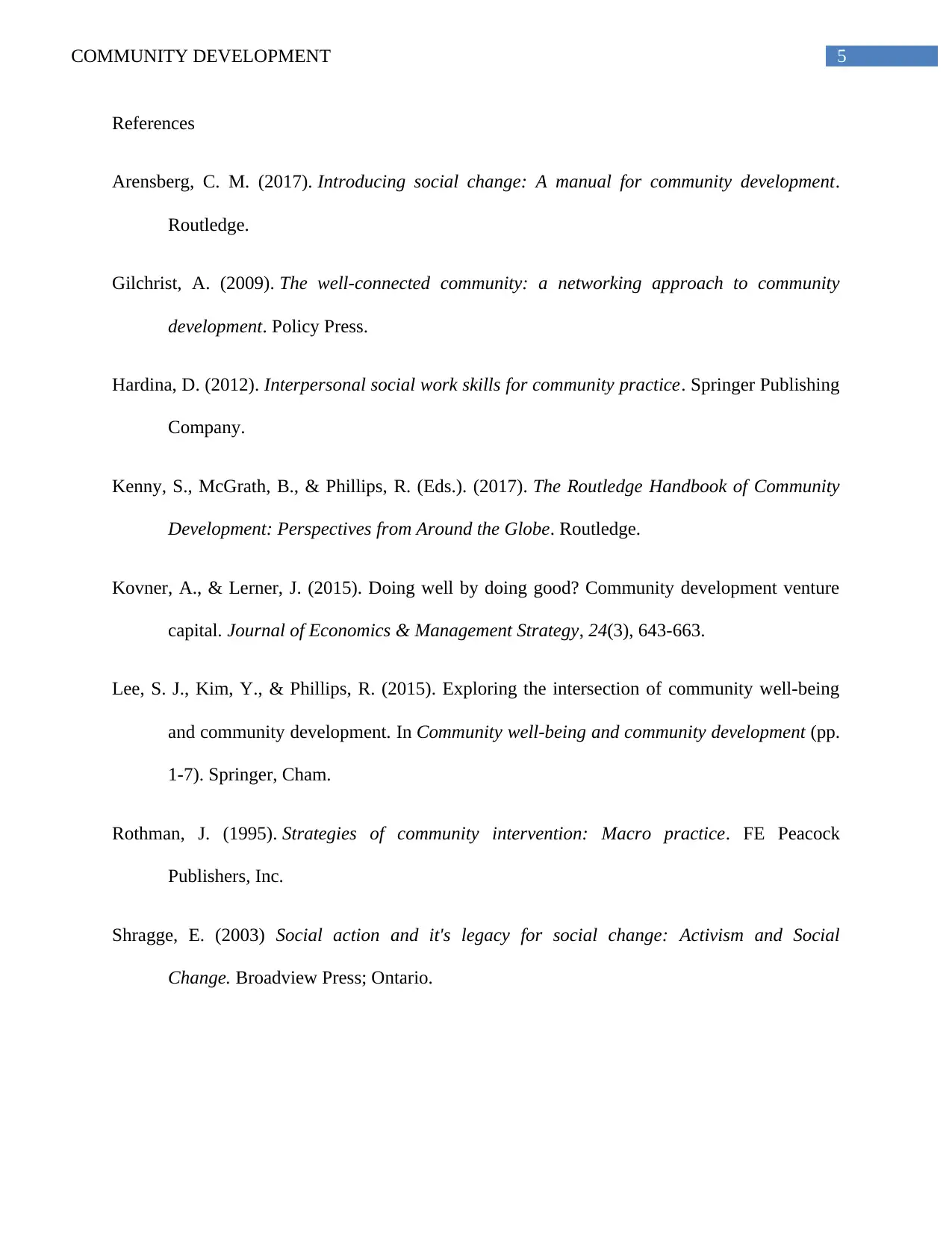
5COMMUNITY DEVELOPMENT
References
Arensberg, C. M. (2017). Introducing social change: A manual for community development.
Routledge.
Gilchrist, A. (2009). The well-connected community: a networking approach to community
development. Policy Press.
Hardina, D. (2012). Interpersonal social work skills for community practice. Springer Publishing
Company.
Kenny, S., McGrath, B., & Phillips, R. (Eds.). (2017). The Routledge Handbook of Community
Development: Perspectives from Around the Globe. Routledge.
Kovner, A., & Lerner, J. (2015). Doing well by doing good? Community development venture
capital. Journal of Economics & Management Strategy, 24(3), 643-663.
Lee, S. J., Kim, Y., & Phillips, R. (2015). Exploring the intersection of community well-being
and community development. In Community well-being and community development (pp.
1-7). Springer, Cham.
Rothman, J. (1995). Strategies of community intervention: Macro practice. FE Peacock
Publishers, Inc.
Shragge, E. (2003) Social action and it's legacy for social change: Activism and Social
Change. Broadview Press; Ontario.
References
Arensberg, C. M. (2017). Introducing social change: A manual for community development.
Routledge.
Gilchrist, A. (2009). The well-connected community: a networking approach to community
development. Policy Press.
Hardina, D. (2012). Interpersonal social work skills for community practice. Springer Publishing
Company.
Kenny, S., McGrath, B., & Phillips, R. (Eds.). (2017). The Routledge Handbook of Community
Development: Perspectives from Around the Globe. Routledge.
Kovner, A., & Lerner, J. (2015). Doing well by doing good? Community development venture
capital. Journal of Economics & Management Strategy, 24(3), 643-663.
Lee, S. J., Kim, Y., & Phillips, R. (2015). Exploring the intersection of community well-being
and community development. In Community well-being and community development (pp.
1-7). Springer, Cham.
Rothman, J. (1995). Strategies of community intervention: Macro practice. FE Peacock
Publishers, Inc.
Shragge, E. (2003) Social action and it's legacy for social change: Activism and Social
Change. Broadview Press; Ontario.
⊘ This is a preview!⊘
Do you want full access?
Subscribe today to unlock all pages.

Trusted by 1+ million students worldwide
1 out of 6
Related Documents
Your All-in-One AI-Powered Toolkit for Academic Success.
+13062052269
info@desklib.com
Available 24*7 on WhatsApp / Email
![[object Object]](/_next/static/media/star-bottom.7253800d.svg)
Unlock your academic potential
Copyright © 2020–2025 A2Z Services. All Rights Reserved. Developed and managed by ZUCOL.





